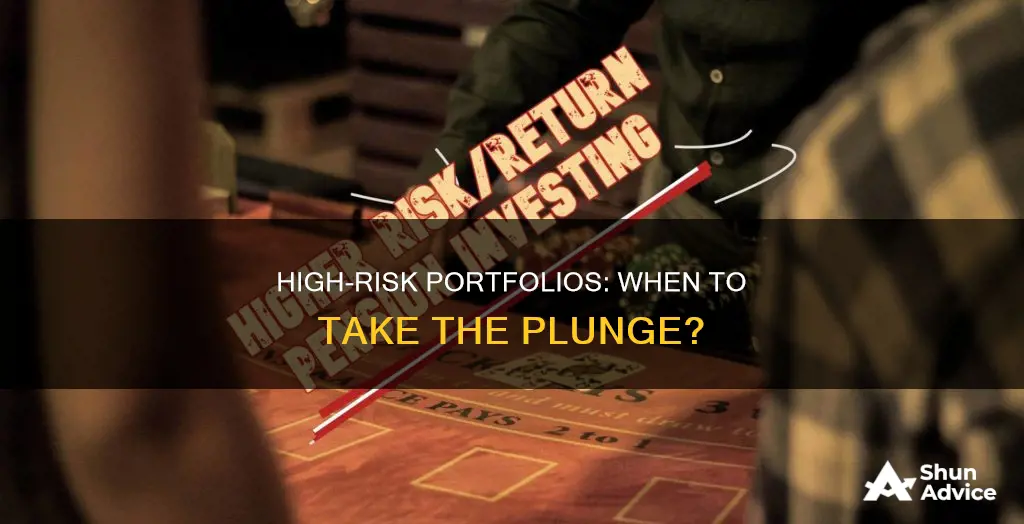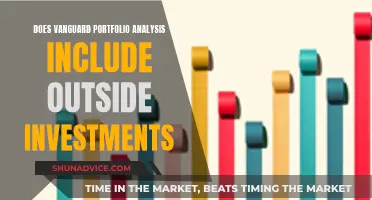
High-risk investments can be tempting because they offer the chance of higher returns than other investments. However, they also put your money at greater risk. If things go well, you could make a lot of money, but if they go badly, you could lose all of your investment. There is not always a direct relationship between risk and reward, and sometimes you may take a risk and not get any reward for it. High-risk investments are also less likely to be regulated, so you may not have access to the same protections if things go wrong.
| Characteristics | Values |
|---|---|
| Risk | Higher risk of losing money |
| Reward | Potential for higher returns |
| Regulation | Less likely to be protected by the Financial Services Compensation Scheme (FSCS) and the Financial Ombudsman Service (FOS)> |
| Volatility | More susceptible to market volatility |
| Management | Requires strong sell discipline and diversification across sectors |
What You'll Learn
- High-risk investments can produce high returns, but you could lose all your money
- Low-risk investments are safer bets with smaller returns
- Penny stocks are high-risk investments that can pay off, but they require due diligence
- High-risk investments are often not regulated, so you may not have access to regulatory protection
- A portfolio with a high percentage of equities is likely to be high-risk

High-risk investments can produce high returns, but you could lose all your money
High-risk investments may offer the chance of higher returns than other investments, but they put your money at greater risk. This means that if things go well, high-risk investments can produce high returns. However, if things go badly, you could lose all of the money you invested. The chance of things going badly is higher, and there is not always a direct relationship between risk and reward. If you are looking for big payouts in a relatively short time period, you will have to accept a disproportionately higher amount of risk.
High-risk investments are not always regulated, and you are unlikely to have access to regulatory protection if things go wrong. For example, if you invest directly in commodities, student accommodation, or crypto, you will not be covered by the Financial Services Compensation Scheme (FSCS) or the Financial Ombudsman Service (FOS). However, the marketing of crypto is regulated, and you can help protect yourself by recognising regulated crypto marketing. Whenever you invest in crypto, you should see prominent warnings about the risk of losing your money, and you should not be offered any free gifts to join or bonuses to refer a friend.
Momentum investing requires strong sell discipline, and investors can also look to diversify across sectors to lower absolute risk. Penny stocks are another example of a high-risk investment, and while financial information sites often dissuade investors from investing in them due to the prevalence of fraud, corruption, and hype, the enormous risks of this investment type can sometimes pay off. Penny stock investing requires exceptional commitment to due diligence, and diversification can help reduce the risks.
Investment portfolios often include a mix of high- and low-risk investments. Low-risk investments are seen as safer bets that typically pull smaller returns, but they come with a certain amount of consistency, which can be reassuring for investors who have a tough time stomaching market volatility.
Liquid Assets: Investment Portfolios for Quick Cash Access
You may want to see also

Low-risk investments are safer bets with smaller returns
Low-risk investments are typically seen as more stable and secure options, as they carry a lower probability of significant losses. This means that while the returns may be smaller, they are more predictable and reliable. These types of investments are well-suited for individuals who prioritize capital preservation and seek a more conservative approach to growing their wealth.
One key advantage of low-risk investments is their ability to provide a steady foundation for an investment portfolio. They can serve as a ballast, helping to balance out the potential volatility associated with higher-risk strategies. By diversifying across both low- and high-risk investments, investors can strive for a more balanced approach that aligns with their risk tolerance and financial goals.
Additionally, low-risk investments often require less active management and can be suitable for those who prefer a more passive investment strategy. They may be ideal for individuals who want to invest for the long term without the need for constant monitoring and adjustment.
It is important to note that while low-risk investments generally entail a lower chance of substantial losses, no investment is entirely risk-free. Even the most conservative options can experience fluctuations in value, and it is essential for investors to conduct thorough research and due diligence before committing their capital.
Fees in Investment Portfolios: What's the Ideal Percentage?
You may want to see also

Penny stocks are high-risk investments that can pay off, but they require due diligence
Penny stocks are considered high-risk investments due to their speculative nature, limited trading volume, and lack of substantial financial history or reliable information about the issuing companies. Penny stocks are also susceptible to severe price fluctuations because their markets are smaller than their larger counterparts. They can also suffer from low liquidity, which makes it difficult for investors to buy or sell these stocks at their desired price.
Despite the risks, penny stocks can be a good investment opportunity for those willing to take on higher risks in exchange for the possibility of high returns. However, it is essential to conduct thorough due diligence before investing in penny stocks. This includes researching the company's business model, financial health, management team, and any recent news or developments. Diversification can also help reduce the risks associated with penny stocks.
It is important to note that penny stocks are not suitable for beginner investors. Many penny stocks represent unproven companies, and the companies that offer them may have lax standards when offering shares. As a result, penny stocks are often associated with fraud, corruption, and hype.
When considering a high-risk investment portfolio, it is essential to understand the potential for bigger losses and larger gains. High-risk investments may offer the chance of higher returns, but they also put your money at higher risk. There is not always a direct relationship between risk and reward, and you may not always get a payout even when you take a risk. Additionally, many high-risk investments are not regulated, so investors may not have access to regulatory protection if things go wrong.
Kroger Savings Club: A Smart Investment Strategy
You may want to see also

High-risk investments are often not regulated, so you may not have access to regulatory protection
High-risk investments can offer the chance of higher returns than other investments, but they also put your money at higher risk. If things go well, you can make a lot of money, but if things go badly, you could lose all of your investment. There is a higher chance of things going badly with high-risk investments, and there is not always a direct relationship between risk and reward. If you are looking for big payouts in a short time, you will have to accept a disproportionately higher amount of risk.
Many high-risk investments are not regulated, so if you invest directly in them, you are unlikely to have access to regulatory protection from the Financial Services Compensation Scheme (FSCS) and the Financial Ombudsman Service (FOS) if things go wrong. Examples of unregulated high-risk investments include commodities, student accommodation, and crypto. However, the marketing of crypto is regulated, and there are some ways to protect yourself, such as recognising regulated crypto marketing and being aware of prominent warnings about the risk of losing your money.
High-risk investments are often not recommended for investors who have a tough time dealing with market volatility. They require a strong commitment to due diligence and diversification to reduce the risks. It is important to be aware of the risks and potential losses before investing in a high-risk portfolio. As a general rule, if your investments can ever drop in value by 20-30%, it is considered a high-risk investment.
Diversifying Your Portfolio: Optimal Number of Investments
You may want to see also

A portfolio with a high percentage of equities is likely to be high-risk
High-risk investments are often not regulated, so if you invest in them, you are unlikely to have access to regulatory protection if things go wrong. Examples of high-risk investments include commodities, student accommodation, and crypto. When investing in crypto, you should always see prominent warnings about the risk of losing your money, and you should not be offered any free gifts or bonuses to refer a friend.
To construct a high-risk portfolio, investors can look to diversify across sectors to lower absolute risk. However, a general market decline will hit a momentum portfolio hard unless the investor is nimble enough to go short. Penny stocks are another high-risk investment type that requires exceptional commitment to due diligence.
Viewing Your Acorns Investment Portfolio: A Simple Guide
You may want to see also
Frequently asked questions
High-risk investments may offer the chance of higher returns than other investments might produce.
High-risk investments put your money at higher risk. This means that if things go badly, you could lose all of the money you invested.
You can reduce the risk of investing in a high-risk portfolio by diversifying across sectors.
Examples of high-risk investments include commodities, student accommodation, crypto, and penny stocks.







